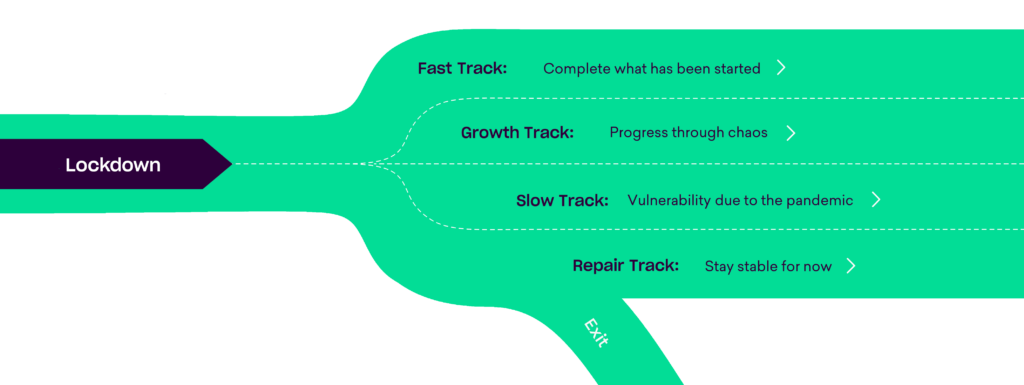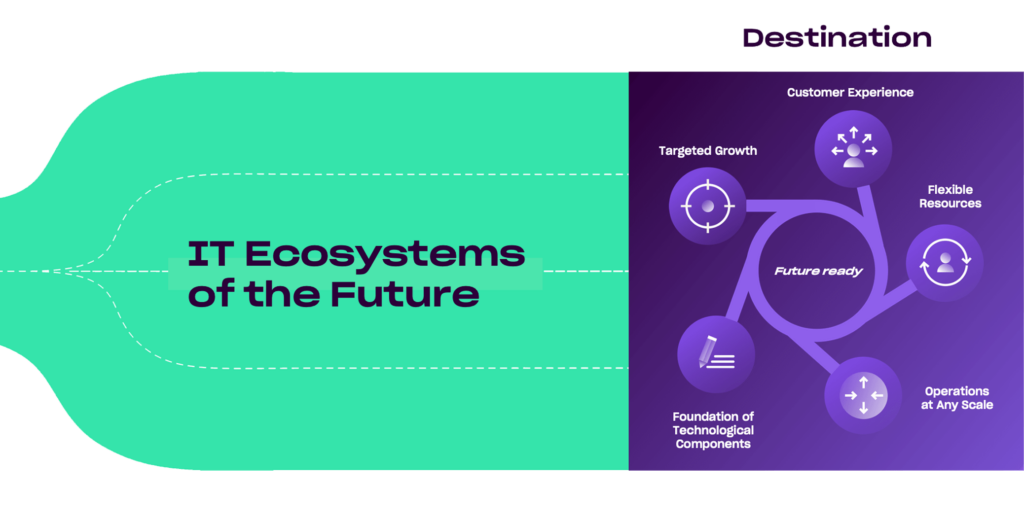
IT Investments and Technological Ecosystems
of the Future
New budget, decisions to be made, a volatile market… Your choices for technology investments and IT ecosystems seemed relatively easy a few years ago, but have suddenly become more complex. The multiplication and specialization of platforms leads to more options and improves the performance of organizations. However, they pose a challenge when it comes to selecting one!
According to Gartner, IT investment growth will be 4% in 2021, of which 7.2% will be in business software. It’s no wonder that today’s businesses are becoming increasingly digital and looking to further automate their operations.
Change the Way You Structure Your IT and Technology Investments
Before reviewing all of your technological investments, first take a step back and take the time to sort out and inventory your business processes. In its Digital Business Acceleration – Where to Focus Now report, Gartner proposes a categorization of investments in order to increase your agility and above all make your IT investments profitable. Take stock of your organization and the decisions to be made by structuring them according to these five prioritization tracks:
- Fast Track: complete what has been started and what can be finalized immediately, often referred to as quick wins. Make permanent changes already underway and with high added value, such as cloud migration, collaboration tools and remote work.
- Growth Track: progress through chaos. Over a few weeks, analyze the changes and behaviours, target what will persist over time and meet your business objectives and once again what improves your processes, your offer or your entire organization (e.g. e-commerce, transport logistics platforms for certain companies, changes to regulations, etc.).
- Slow Track: put off projects that fix your internal loopholes, that is, investments that meet long-term goals but have no short-term impact. (e.g. cosmetic investments on your platforms, in the back office of your organizations).
- Repair Track: stay stable for now. Fix platforms and systems that were great before, but suddenly no longer fit. You still need them, so consider them to stay the course for the future.
- Exit Track: decommission what has been made unnecessary in your ecosystem. Cut some budgets even if the projects have been started (e.g. local infrastructure, audiovisual or telecommunications for physical offices, etc.).

Every organization is different. Consider the impact for YOU, then allocate your budget and resources where YOUR value is!
What Are the IT Ecosystems of the Future?
This categorization leads us to shape the IT ecosystems of the future based on your corporate culture to ensure you are future ready. It is also important that these ecosystems and environments support your organization’s long-term spheres of activity.
- Customer Experience: your consumers are increasingly demanding and expect the same omnichannel experience, and fast, efficient and quality 360-degree follow-up.
- Flexible Resources: organizations need to be more agile and adapt quickly, regardless of their environment.
- Operations at Any Scale: operations must adapt to fluctuating demand and over-demand to be ready for peaks and seasonality, while equipping yourself to lower your operating costs in times of low income (for example by using the cloud for pay-as-you-go billing).
- Targeted Growth/Foundation of Technological Components: it is better to predispose yourself to grow portions of the organization without impacting the rest, to evolve without having to invest in all spheres of the business.

So, using the different investment speeds, make sure you take these fundamental components into account, giving you an even more integrated and successful ecosystem of the future.
From Custom Development to Best of Breed Integration
Besides the change in the nature of investments and the consideration of the impact of our choices on new spheres, we also denote a change in the nature of the platforms selected. Indeed, more than a decade ago, custom code and custom software creation were prevalent in the development world. Then, end of the 2000s, huge operating systems and integrated management software packages (ERP) took pride of place at the heart of companies.
Today, we are seeing a shift from bespoke development to the integration of best of breed solutions, ultra-specialized software and components. The key to the ecosystem of the future now lies in connecting all these cutting-edge platforms. So has custom code become a convenience? It will never disappear, but we simply use it differently!
What Are the Recent Changes in IT Ecosystems?
The decision-making process must be revolutionized. At a higher level, major changes in strategic management have emerged:
- Decision-making is no longer done at the departmental level, but rather at company level. The overall business goals must be served by technology, but it must now also serve multiple departments at once. After all, CRMs aren’t just for sales anymore, but also for marketing, after-sales service, finance, etc.
- Technology platforms and systems are increasingly personalized and specialized in order to offer you a more enriched experience.
- Specialized components are integrated to make your processes more efficient, and this, in a way that is personalized to your organization. Granted, you have more licences with more vendors, but you enjoy increased performance while reducing risk during changes, since you are no longer dependent on a single platform.
- These same solutions meet several business needs of several separate units. We must therefore analyze and choose the platforms differently, depending on the whole organization rather than for a single department as was done before.
Clarify and prioritize your technology initiatives to maximize your investments and meet your urgent business needs, current and future. Support your growth intelligently and face market volatility while responding to the growing complexity of your technological environment!
Need help clarifying the most appropriate IT investments for your business?
Written by Vincent Godcharles, Logient CEO



















